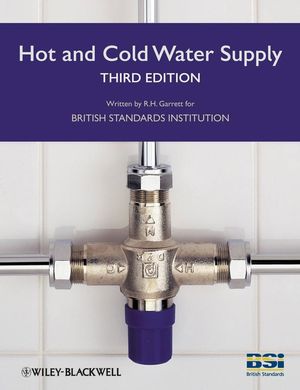Hot and Cold Water Supply, 3rd EditionISBN: 978-1-4051-3002-8
Paperback
424 pages
October 2008, Wiley-Blackwell
 This is a Print-on-Demand title. It will be printed specifically to fill your order. Please allow an additional 10-15 days delivery time. The book is not returnable.
|
||||||
Introduction.
1 General considerations.
1.1 Scope of the standard.
1.2 Water Regulations.
1.3 Building Regulations.
1.4 The Health and Safety at Work etc. Act 1974.
1.5 Definitions.
1.6 Graphical symbols.
1.7 Materials.
1.8 Initial procedures.
2 Cold water supply.
2.1 Drinking water.
2.2 Cold water systems.
2.3 Storage cisterns.
2.4 Valves and controls.
2.5 Water systems outside buildings.
2.6 Water revenue meters.
2.7 Boosted systems.
2.8 Water treatment.
3 Hot water supply.
3.1 System choice.
3.2 Instantaneous water heaters.
3.3 Water-jacketed tube heaters (primary stores).
3.4 Storage type water heaters and boiler heated systems.
3.5 Primary circuits.
3.6 Secondary hot water distributing systems.
3.7 Components for hot water systems.
3.8 Hot water provision for the less able.
4 Prevention of bursting.
4.1 Energy control and safety devices.
4.2 Pressure and expansion control.
4.3 Control of water level.
5 Pipe sizing.
5.1 Sizing procedure for supply pipes.
5.2 Tabular method of pipe sizing.
5.3 Sizing cold water storage.
5.4 Sizing hot water storage.
5.5 Legionella – implications in sizing storage.
6 Preservation of water quality.
6.1 Materials in contact with water.
6.2 Stagnation of water and Legionella.
6.3 Prevention of contamination by cross connection.
6.4 Backflow protection.
6.5 Backflow prevention devices.
6.6 Secondary or zone backflow protection.
6.7 Application of backflow prevention devices.
7 Frost precautions.
7.1 Protection from frost.
7.2 Protection of pipes and fittings.
7.3 Draining facilities.
7.4 Insulation against frost damage.
8 Water economy and energy conservation.
8.1 Water economy.
8.2 Grey water and recycled rainwater.
8.3 Energy conservation.
8.4 Building Regulations and energy conservation.
8.5 Insulation to meet Building Regulations.
9 Noise and vibration.
9.1 Flow noises.
9.2 Water hammer noise.
9.3 Other noises.
9.4 Noise transmission and reduction.
10 Accessibility of pipes and water fittings.
10.1 Pipes passing through walls, floors and ceilings.
10.2 Stopvalves.
10.3 Water storage cisterns.
11 Installation of pipework.
11.1 Steel pipes.
11.2 Copper pipes.
11.3 Stainless steel pipes.
11.4 Plastics pipes.
11.5 Iron pipes.
11.6 Asbestos cement pipes.
11.7 Lead pipes.
11.8 Connections between pipes of different materials.
11.9 Connections to cisterns and tanks.
11.10 Branch connections for buildings.
11.11 Contamination of mains.
11.12 Laying underground pipes.
11.13 Pipework in buildings.
11.14 Electrical earthing and bonding.
11.15 Jointing of pipework for potable water.
11.16 Testing.
11.17 Identification of valves and pipes.
12 Commissioning and maintenance of pipelines, services and installations.
12.1 Inspections.
12.2 Testing for soundness.
12.3 Testing methods.
12.4 Flushing and disinfection.
12.5 Commissioning hot water and heating systems.
12.6 Maintenance.
12.7 Locating leaks.
12.8 Disconnection of unused pipes and fittings.
12.9 Occupier information.
13 Firefighting systems.
13.1 Fire safety.
13.2 Openings for pipes.
13.3 Fire mains within buildings.
13.4 Certification and accreditation of fire protection installations.
14 Sprinkler systems for domestic and residential premises.
14.1 Scope of BS 9251.
14.2 Terms and definitions.
14.3 Consultation.
14.4 Sprinkler systems and water supply methods
14.5 Pressure requirements and system flow rates.
14.6 System components.
14.7 Installation.
14.8 Commissioning sprinkler systems.
14.9 Maintenance.
14.10 Documentation.
14.11 Hydraulic calculations for sprinkler systems.
British Standards relevant to this book.
References and further reading.
Index.



